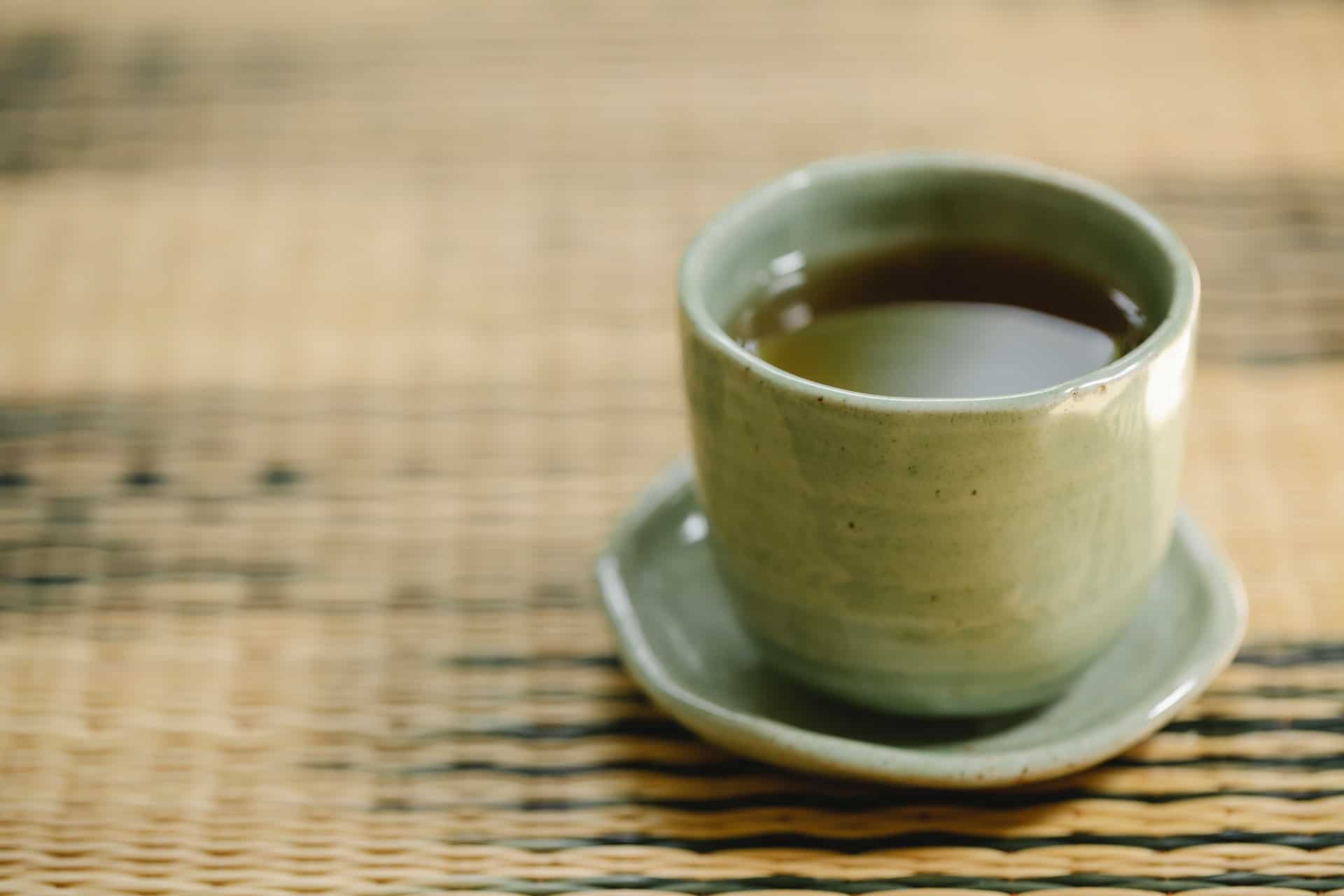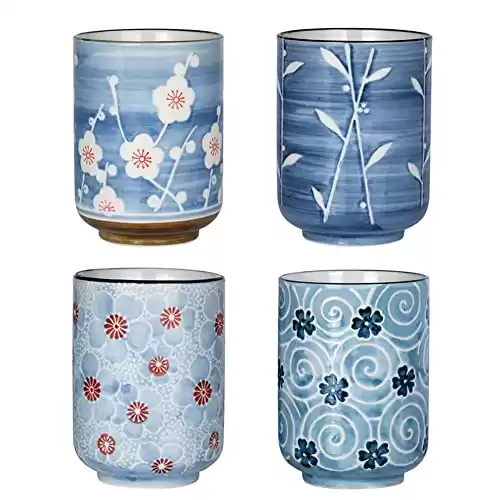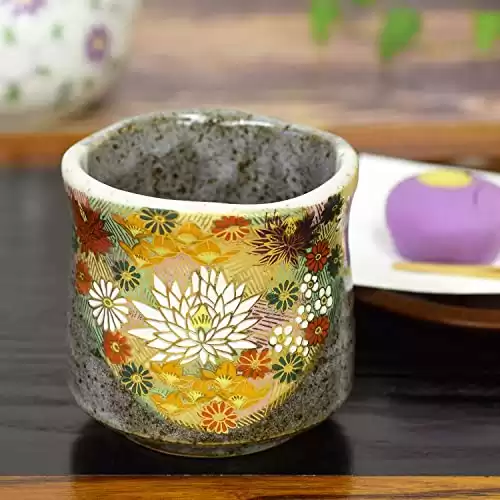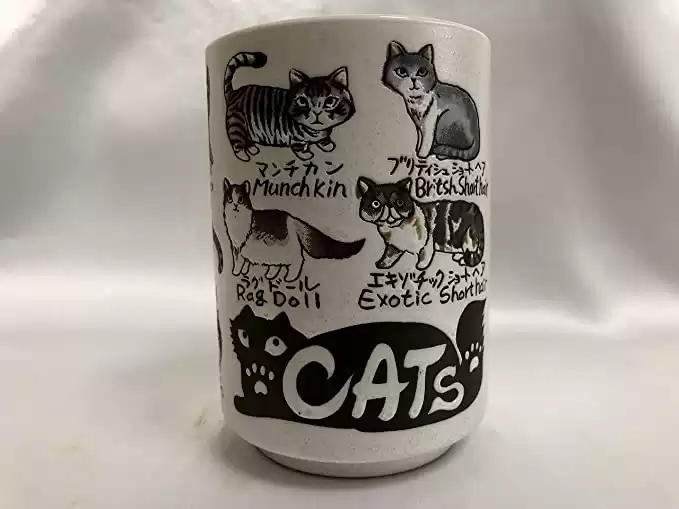If you are like most western tea drinkers you use a mug or cup to enjoy your favorite brew. You are not alone! In fact, it’s our culture to have drinking vessels with handles. What if I were to tell you there were a select group of teacups with no handles?
These cups are called Yunomi and are from Japan.

History of the Japanese teacup
They are also called Japanese tea mugs. They hold eight ounces of tea and come in many different shapes and sizes. Yunomi cups are missing one element, a handle. There is an art to the Japanese Tea Cup. Without the handle, you are more inclined to cup the teacup in your hand and feel the warmth of the tea. This benefits the tea drinker in many ways. Feeling the warmth of the cup is one of those ways.
The art of the Japanese teacup also has a very interesting history.
Tea came to Japan through two Buddhist monks who visited China. The Buddhist monks by the name of Kuwait and Saicho share credit for bringing tea seeds to Japan. That first tea was a brick tea. Brick tea is a tea that is condensed or formed into a brick where the tea leaves are compressed into a brick form.
At a time in history called the Edo Era during the years 1603 and 1868. Japan was under the rule of the Tokugawa shogunate. The Edo period was the final period of traditional Japan and a time of people, stability, and growth. During this time the economy was starting to grow. Drinking tea was reserved for the religious wealthy. But, during the Edo Era tea became popular with everyone. With the tea also came the utensils to drink with, the Yunomi or Japanese Tea Cup.
Such consideration goes into serving tea in a yunomi. The entire Japanese Tea Ceremony is about the guest, the season, and the tea served. All go into the consideration of what Yunomi will fit the season and ceremony. The cups chosen during the winter months are pottery. During the summer months, you choose porcelain.
The way you hold a Japanese Tea Cup envelops the five senses while drinking the tea.
- The sight of the tea as it dances in your cup
- The sound of the water as it cascades into the cup
- The smell of the tea as it news in your cup
- The taste of the tea as you take your first sips
- The feel of warmth as you hold the teacup in your hands
There is a special way of cupping a teacup without handles. It brings you close to the tea, the environment, and the warmth. Cupping your tea also gives you an indication that your tea is served at the correct temperature. Making it the best tea you can drink.
What do the Japanese drink in their teacups? Generally, it’s green tea (sencha, Blanchard, or kukicha).
Yunomi is the most common type of Japanese teacup and is for daily usage. Holding 8 ounces of tea. The creation of Yunomi goes back to the 16th century.
Creative yunomi
There are two forms of Yunomi. Stoneware is one and the other is Porcelain. Each with its strong points and connection with the history of the Japanese Tea Cup. Both porcelain and stoneware are created in Japan by hand as well as by larger industrial sites.
Porcelain Yunomi does not change, what you see is what you get and over time it remains the same
Stoneware Yunomi is designed to change over time. Its perfection is in its imperfections. I love the sound of this quote. Stoneware that’s created by hand. Its personality is in all the little dents, bubbles, and uniqueness. The “flaws”. It’s a cup that is one of a kind, never duplicated, and never mass-produced. I love that!
Hagi – is a delicate translucent white glazed stoneware that is fired under high heat. Its origins are in the Korean style of pottery making. In the 15th century, many potters from Korea were brought to Japan due to a war campaign on the Korean peninsula. These potters began to make their pottery and the style continued in Japan. The cups are rustic and some contain irregular shapes. One style you may be familiar with is a cup with a milky-white glaze on it.
Shino – Japanese first white glaze is Shino. The name may have come from the word white in Japanese which translates to Shiro. Developed in the 16th century. White-glazed pottery with textured skin. The Shino cup is loosely designed and fashioned to fit in the wabi-sabi fashion (see below). The surface is imperfect with pinholes, crazing, and crawling.
Karatsu – Karatsu means Te port to the Tang China dynasty. The potters are located on Tsushima Island and Loki Island. Again, this pottery is fashioned after Korean pottery. Well known for its simple and relaxed shape. History suggests that Karatsu was created in the surrounding areas of Kishidake castle under the Hata family. There is an old saying in the ranking of tea bowls: “First Ido, second Hagi, third Karatsu”. Currently, there are over 70 kilns operating in the Karatsu area. Each kiln exhibits its own unique style. These styles are based on the techniques passed down through Karatsu’s long history. Each artist’s particular approach is also a part of the unique creation.
Mashiko – This town outside Tokyo is known for its pottery. The type of clay used is rich in silicic acid and iron. It’s easy to shape and fire. Created in the Edo period from 1603 to 1868.
The early mashikoyaki style was a simple brown with red glaze pottery. This effect is obtained from the use of the local red-brown clay. In the early part of the 20th century, Shoji Hamada, another famous Japanese potter, encouraged more creative freedom. Shoji’s style was not always understood. Today it is embraced. So now, there are many interpretations of the mashikoyaki.
Mento Yunomi – These are matching Japanese Tea Cups with one being slightly smaller than the other. These are given as wedding gifts. If you had not already guessed it, the larger cup is for the husband and the smaller for the wife.
Wabi-sabi – Using the potter’s hand with imperfections is my best way to explain the Wabi-Sabi creation. It embraces simplicity and uses materials that can cause distortion. It is loosely created and not one will match the other and will not be mass-produced. Once the potter molds the Japanese Tea Cup the cups are put in the kiln. When the cups are removed they are dipped in water or straw. Dipping will further the imperfections by warping or cracking. The results are uneven, pitted, cracked, and a multi-shaded cup. These cups are carefully crafted and not just thrown together.
Made in Japan, in Ishikawa. Famous Japanese traditional Pottery KUTANI since 1655
Size:(H) 3.1inches x (D) 3.3inche
Japanese tea ceremony
It is only fitting we talk a little about the Japanese tea ceremony or Chanoyu. This is where the teacups join the ceremony. The Japanese tea ceremony is a relaxing meditative ceremony. The word Chanoyu means ‘hot water for tea”. The ceremony can also be called Chado or “Way of Tea”.
There are movements that are purposeful in performing this ceremony. The ceremonial outcome is a simple pure cup of tea usually powdered green tea (Matcha). There are actually two different ceremonies. One ceremony is less formal and lasts under an hour called Chakai. The Chaji is very formal and lasts for four hours and is served as part of a meal.
The items needed for Chanoyu are:
- Kensui – waste bowl for overflow and spillage
- Chawan – These are the Japanese teacups we talked about.
- Futa-oki – a lid rest for the kettle lid
- Hishaku – a bamboo ladle used for serving the tea
- Chasen – or wooden whisk used to stir the matcha
- Chakin – White cloth to clean the tea bowl
- Mizusahi – holds fresh water for the ceremony
- Chashaku – long wooden spoon (matcha scoop)
- Natsume – Matcha holder
- Kama – the iron kettle
If you have a chance to view or sit in on a Japanese Tea Ceremony please do. Its roots are grounded in history and precision. The art of bringing oneself and others into a meditative and peaceful state.
Conclusion
The word that comes to me is diversity. Tea diversity. I love to learn about different cultures and learning about Japanese teacup is no different. There is so much history. I love the history of the teacup and my favorite thing is the wabi-sabi fashion of creation.
The fact that these cups are unique and flawed (in a sense) makes me love them more. In a world full of manufactured products it’s so nice to see into a world of hand-created pottery cups with no handles. While some may call them Japanese tea mugs it does not fit the description of a mug at all.
There is a sense of ownership when cupping the teacup. Draw the cup close to your heart as you inhale deeply its contents and let it go. Meditative and peaceful. Patiently waiting for that first sip. Close your eyes. Take a sip, and let it linger. Remember Yunomi, the cup with no handles has brought you closer to yourself. What an honor and privilege.





1 thought on “The Art Of The Japanese Teacup”
Pingback: How To Choose An Authentic Chinese Tea Cup - My Tea Vault